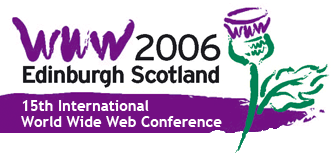
|
|
W3C Track Sessions
The W3C official page from which this track's information is derived is available on the W3C site at http:/www.w3.org/2006/05/w3c-track.html. Mobile Web Initiative11:00-12:30, Wednesday 24th May Session Chair: Dominique Hazaël-Massieux (W3C) Dominique Hazaël-Massieux Details to be confirmed Daniel Appelquist Details to be confirmed James Pearce Details to be confirmed James Pearce Charles McCathie Neville Roland Geisler Arun Ranganathan Paul Walsh Dan Appelquist Details to be confirmed Rich Web Applications14:00-15:30, Wednesday 24th May Session Chair: Dean Jackson (W3C) Dean Jackson Details to be confirmed Art Barstow Details to be confirmed Steven Pemberton Details to be confirmed Accessibility 2.016:00-17:30, Wednesday 24th May Session Chair: Shawn Henry (W3C) Details to be confirmed Details to be confirmed Details to be confirmed
The Web Everywhere11:00-12:30, Thursday 25th May Session Chair: Max Froumentin (W3C) Jim Larson The W3C speech interface framework languages (including VoiceXML 2.0/2.1) have been widely deployed. The focus is now on CCXML,VoiceXML 3.0, and SCXML, a state-transition language for managing the control flow of applications, expecially voice and multimodal applications. These languages will enable new and exciting speech and multiple applications. Kazuyuki Ashimura This presentation focuses on the recent activity of internationalizing speech synthesis and SSML, and will present the issues and requirements that have arisen from the recent workshops and the work of the Voice Browser Working Group. Dave Raggett The Ubiquitous Web as a synthesis of the Web and ubiquitous computing that extends the Web out into the physical world: importance of context awareness, device coordination, role of Semantic Web, trust, identity and security. Web Service: Towards the Next Stepss14:00-15:30, Thursday 25th May Session Chair: Hugo Haas (W3C) Jacek Kopecky Details to be confirmed After SOAP 1.2 and MTOM standards, WS-Addressing 1.0 is coming to an end and the work on WSDL 2.0 has also progressed (implementation testing stage). Web services infrastructure work has therefore started on nextsteps: facilitating the work of developers by defining a set of XML Schema patterns efficiently implementable by the broad community who use XML databindings, and building a simple and generic support for semantics in Web services. Newest XML tools: Queries, Transformations16:00-17:30, Thursday 25th May Session Chair: Liam Quin (W3C) Liam Quin Details to be confirmed Details to be confirmed Daniela Florescu There is no agreed upon definition of what Web 2.0 is but everybody has a personal definition. This talk will describe our interpretation of how a new generation of applications on the Web will be built. It will look at the current architectures and see why they do not satisfy the requirements of Web 2.0 (as we understand them). It will explain why we believe that Web 2.0 applications will rely on XML not only for serialization but as a fundamental underlying information model. We believe that there will be no more (or very little) Java or SQL code in this new generation of applications. Unfortunately the existing XML stack of technologies isn't complete at this point. In the talk we will also list the extensions we think will be needed in order to fulfill the goal of an XML-based declarative information hub as a fundamental architecture for such applications. Advances in Semantic Web for HealthCare/Life SciencesSession Chair: Eric Miller (W3C) Eric Miller Details to be confirmed Eric Neumann Details to be confirmed Susie Stephens Details to be confirmed Health care practices and bioinformatics have already succeeded in utilizing database management, workflow and information retrieval technologies, which have provided syntactic search, heterogeneous data access and sharing, and limited forms of integration. We can realize more exciting potential of health care and life science if we have more automated ways for analysis leading to insight and discovery. Ben Adida Details to be confirmed Style and LayoutSession Chair: Bert Bos (W3C) Bert Bos The status of CSS2 and a demo of layout in CSS3. After much work on the implementations and the specification, we are finally reaching a well-supported CSS level 2. About 70% of all pages now use CSS. Designers are becoming more confident and push CSS2 to its limits. After an overview of the status of CSS, we'll end with a preview of a new grid layout scheme for CSS3. Details to be confirmed Kevin Lawver As more and more sites syndicate small chunks of markup, theintegration of "foreign" CSS is causing all kinds of headaches fordevelopers and site owners. This presentation will cover strategies for both site owners and syndicators to make sure these modules don't cause any more headaches. Challenges in Web SecuritySession Chair: Thomas Roessler (W3C) Thomas Roessler Presenters and a panel will look at the challenges to Web security that emerge as the Web's potential as a platform for applications and services is explored: How do we make Web authentication usable -- and what does that mean? How do today's approaches to mutual authentication mix with mash-ups, RESTful Web services, and ubiquity? How does today's browser security model mix with the needs of rich Web applications? W3C Track Chair
Additional questions about the WWW2006 Workshops can be emailed to www2006-w3c@www2006.org. |
Platinum SponsorsSponsor of The CIO Dinner |
 |